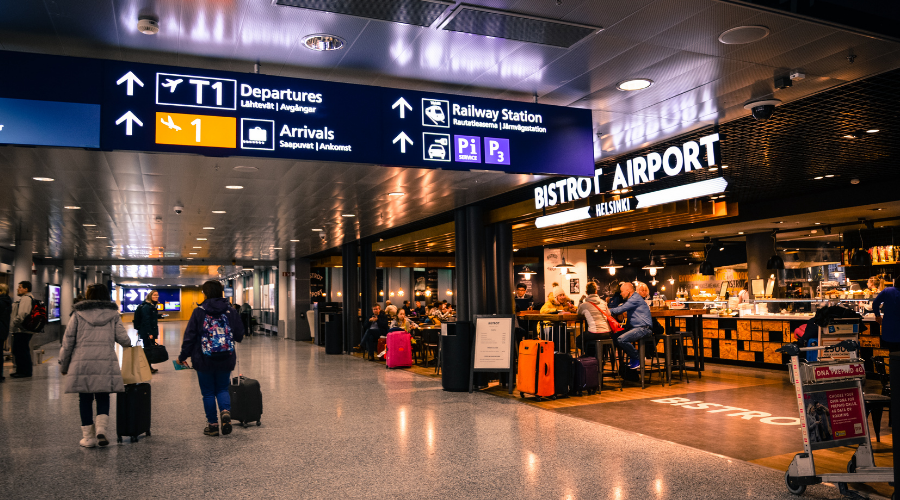Boosting Traveler Experiences and Business Revenues at Airports with Video Intelligence

The Key to Happy Travelers in an Airport: Data Intelligence
A successful airport not only moves aircraft, cargo, and people efficiently, but also ensures a positive, comfortable experience for air travelers, and a profitable investment for the tenant businesses located in the airport terminals. Air travelers want less traffic and crowding; fewer, shorter lines and wait times; as well as a variety of services and hospitality comforts.
Airports can make their terminals more inviting to travelers by offering a broad choice of popular amenities, such as restaurants, retail stores, and lounge areas; optimizing the flow of vehicle and pedestrian traffic; controlling crowds and queues; and maintaining clean facilities. For some travelers, these are considerations when choosing flight paths and departure airports. Typically, these responsibilities are driven by a variety of airport business units, ranging from sales and business development, to merchandising, operations, security, marketing, and advertising. Each of these departments must regularly make decisions that impact revenues and the guest experience; and – the more they base those decisions on actionable, quantifiable data – the more likely they will succeed and meet their goals and objectives.
Beyond the aviation authority or airport executive management, there are other key stakeholders that can drive these successes when empowered with business intelligence: The tenant businesses can also leverage crucial data for driving customer engagement, satisfaction, and return visits.
Video Intelligence for Uncovering Valuable Airport Insights
One medium to uncover this intelligence is video analytics software, which leverages existing video surveillance systems and, powered by Artificial Intelligence and Deep Learning, makes video data searchable, actionable and quantifiable. The technology identifies, classifies and indexes objects detected in surveillance video, so that video can be:
- Searched to accelerate investigations
- Configured to trigger real-time alerts
- Visualized in heatmaps and dashboards for informed decision-making
Whether video data is processed on demand for streamlining forensic investigations; analyzed in real-time for increased situational awareness, quick assessment, and rapid response to developing situations; or aggregated in the long term for understanding visitor trends and patterns, video data can provide critical insight for different users and organizations.
For example, an airport can leverage demographic data as well as traffic volume and flow statistics, to address operational inefficiencies in a terminal – from understanding choke points in the traveler journey from parking lot to the gate to identifying areas that need more regular maintenance, as opposed to underutilized spaces, which may require less frequent attentions. In real-time, these same data points could be used for triggering alerts when crowd formations are detected, so that security can assess how best to intervene to keep traffic moving safely. After a crowding incident takes place, key stakeholders can draw conclusions about what went wrong and how it can be prevented in the future with focused video investigation of the relevant footage and key factors that contributed to the incident.
Generate Revenue Based on Behavioral Intelligence
Of course, these value points can extend beyond the airport management team to the businesses leasing retail and restaurant space in a terminal. Video data can be used both as a tool for airports to better serve and cater to – as well as identify and attract the right types of – tenants. Uncovering demographic and navigational insight about terminal trends is important for identifying where to place appropriate services and attractions, so that locations meet the needs of the airport travelers. It also enables airport sales managers to demonstrate the commercial value of a tenant space when leasing to tenants. Thus, this business intelligence enables both data-driven layout planning and space utilization, as well as tenancy business development.
This intelligence can also empower terminal tenants with insight into visitor traffic to help them develop targeted marketing, advertising and merchandising, plan staffing for peak traffic times, and more.
- Drive Targeted Marketing and Advertising
By delivering granular insight into visitor demographics, marketing professionals can identify their audience for more targeted campaigns; assess the efficacy of their efforts based on display interactions and traffic to specific store spaces; and strategize about attracting new audiences with data-driven merchandising and advertising decisions.
- Streamline Operational Efficiencies
Operations managers must ensure smooth traffic flows, optimal security, and excellent maintenance by understanding where and when traffic bottlenecks occur and triggering alerts whenever crowd or queue formations are detected. This can similarly be leveraged for enforcing occupancy restrictions, scheduling usage-based maintenance and cleaning, and ensuring that adequate staff are available based on peak traffic times.
- Accelerate Incident Response and Investigation
When incidents occur – from overcrowding and unwieldy queues to inventory theft – businesses can leverage video content analysis to complement existing video surveillance systems, trigger alerts for unexpected or suspicious behavior, and accelerate investigations for driving future prevention.
Video analysis, combined with traditional surveillance, provides airports and their tenants with both real-time and long-term intelligence that empowers them to make strategic decisions based on quantifiable, actionable information. They can thereby improve traveler and guest services, which will increase revenues for both the airport and aviation authority, as well as their tenant businesses. The benefits are felt by all stakeholders: travelers, business tenants, and the airport itself.
Signup to receive a monthly blog digest.